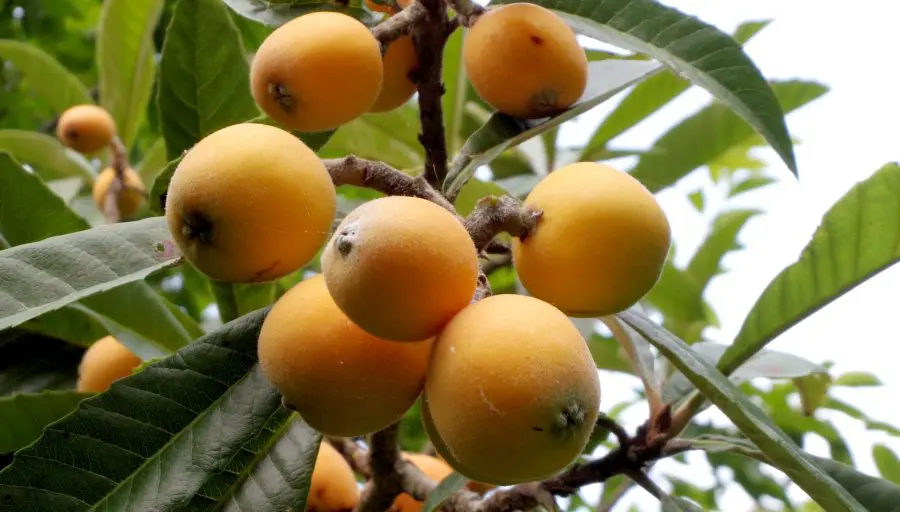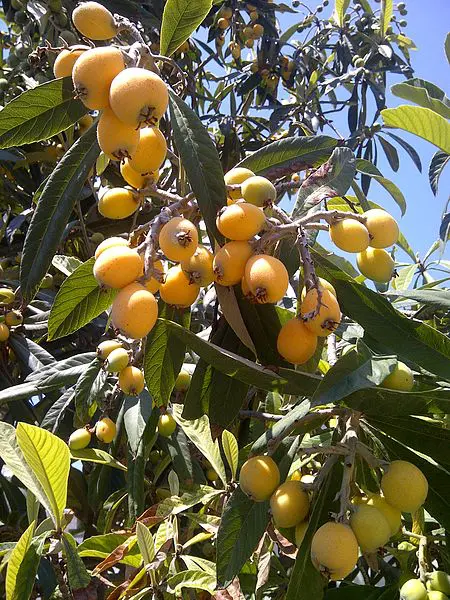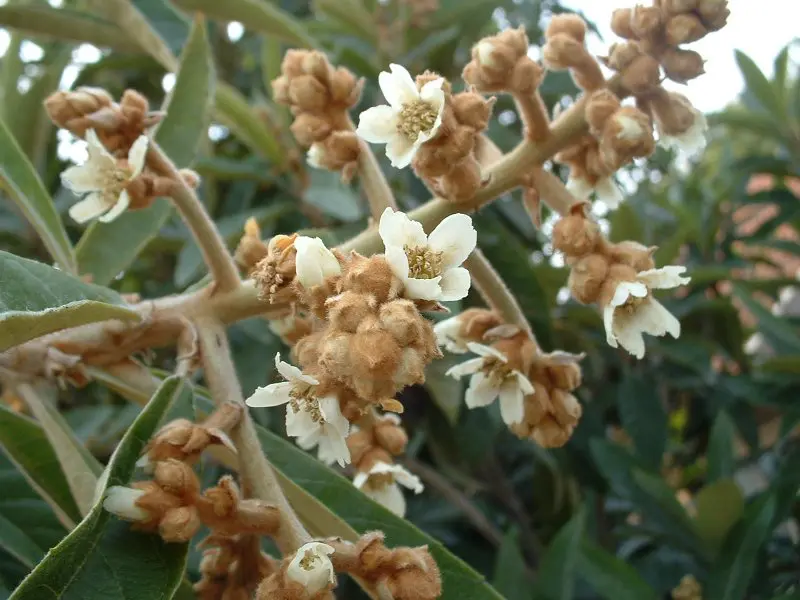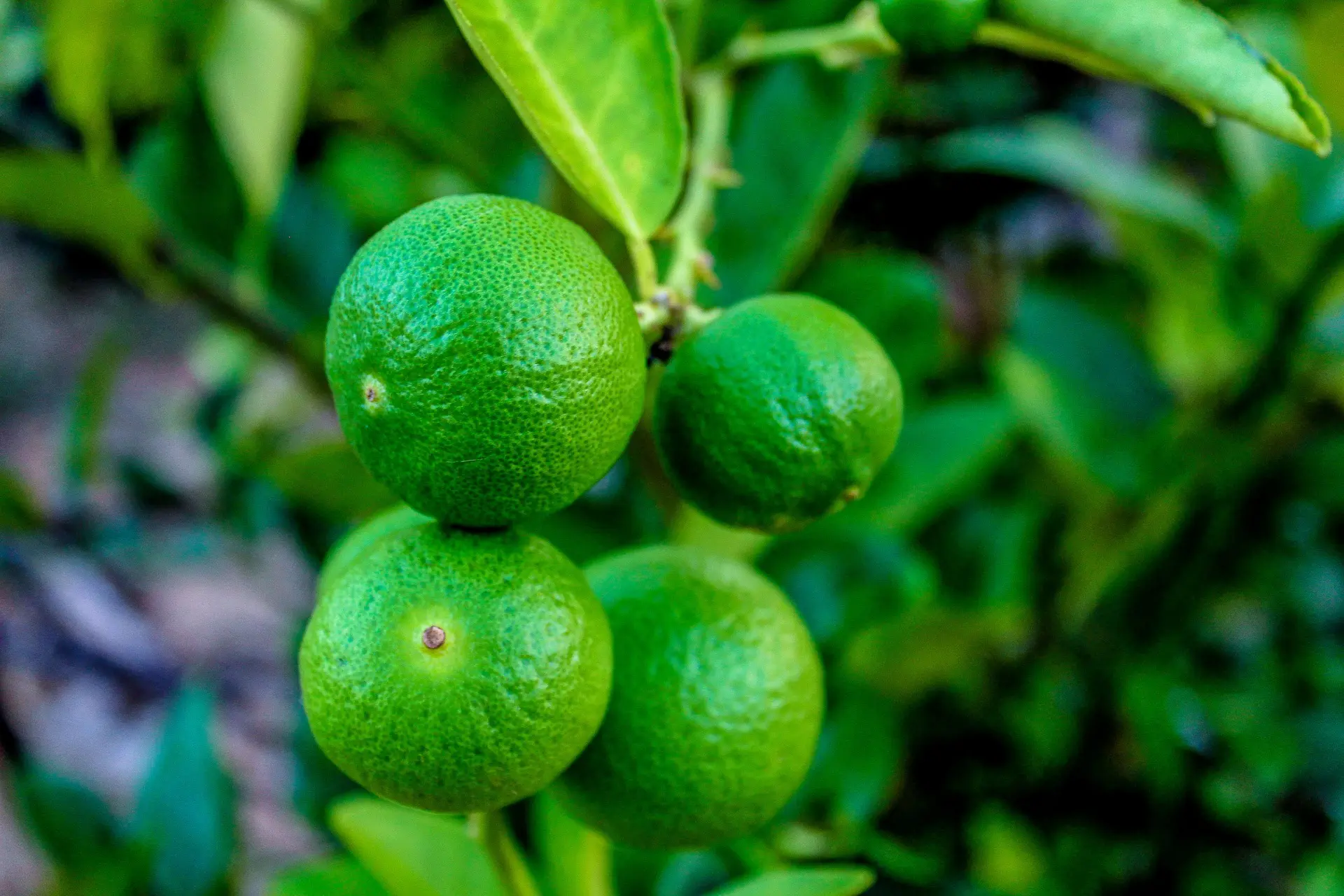This post contains affiliate links. If you buy something from one of our links we may earn a commission. Thanks

Did you know growing loquat trees in pots is entirely possible indoors? Loquat trees are a lesser-known, but highly rewarding citrus fruit tree to grow in a home garden.
Growing loquat trees in pots requires a large container with good drainage and well-draining soil. Place the pot in a sunny location and water when the soil’s top inch is dry. Fertilize with a balanced fertilizer every 6-8 weeks for optimum growth and fruit production.
Not only do they produce delicious fruit, but they also have attractive foliage and can be grown in a pot, making them suitable for small spaces. If you’re interested in growing your own loquat tree in a pot, here’s what you need to know.
What Is A Loquat?
The loquat tree (Eriobotrya japonica) is a small, evergreen tree that is native to Southeast China. It is part of the Rutaceae family and is closely related to citrus.
The tree typically grows to be around 15-30 feet tall and has a rounded canopy with glossy, dark green leaves.
Loquat trees produce clusters of small, yellow, or orange fruit that have a tangy-sweet flavor and a soft, downy exterior.
The fruit is often eaten fresh or used in jams and jellies. It is sometimes called Japanese medlar, a Japanese plum tree, or a Florida plum. It does have a large pit like other stonefruits.

Loquat trees thrive in warm, subtropical climates and are commonly grown in areas such as California, Florida, and the Mediterranean.
They prefer well-draining soil and full sun and can tolerate drought conditions once established.
Loquat trees can also be grown in pots, making them suitable for small spaces.
In addition to their edible fruit, loquat trees are also valued as an ornamental tree in the home landscape for their attractive foliage and can make a nice addition to a home garden. More information here.
What Do Loquats Taste Like?
Loquat fruits have a tangy-sweet flavor that is often described as a cross between an apricot and a plum. The flesh of the fruit is soft and juicy, with a texture similar to a peach.
They are generally known for their sweet, tropical taste. The fruit can be eaten fresh, or it can be used in jams and jellies, or cooked into sauces or syrups.
Loquats are a good source of vitamin C and other nutrients, and they are often eaten as a healthy snack or used as an ingredient in fruit salads or other dishes.
Can You Grow Loquats Indoors?
While it can be a bit more challenging to grow a loquat tree indoors compared to growing them outdoors, it is certainly possible to grow loquats in containers with the right care and attention.
If you are able to provide the tree with a sunny location, adequate light, and a warm environment, you may be able to successfully grow a loquat plant indoors.
It will be important to choose a dwarf or semi-dwarf variety and to plant the tree in a large enough pot to allow for proper root growth.
You will also need to monitor the tree for pests and diseases and provide it with proper watering and fertilizing to ensure its health and success.
With the right care, you can enjoy the rewards of growing a loquat tree indoors.

Selecting a Loquat Tree
When it comes to choosing a loquat tree, it’s best to go with a dwarf or semi-dwarf variety as they are better suited for growing in pots.
Some good options include the ‘Gold Nugget’ and ‘Takumi’ varieties. It’s also important to consider the age of the tree. Young trees will have a better chance of establishing themselves in a pot than an older, more mature tree.
As for where to buy a loquat tree, you can try checking with a local nursery or do an online search.
Keep in mind that loquat trees can be somewhat hard to come by, so you may have to search around a bit to find one.
It is possible to buy loquat seeds but seeds can produce more variable results for fruit quality and size than planting a known variety.
Growing Loquat Trees In Pots
Loquat trees are strong growers with strong root systems so they will need a larger pot than some other citrus trees.
Choosing The Right Pot
When it comes to choosing a pot for your loquat tree, size is important. A pot that is too small will not allow for proper root growth, while a pot that is too large will hold too much soil, which can lead to over-watering and eventually root rot.
A good rule of thumb is to choose a pot that is at least 20 inches in diameter for a dwarf variety or 30 inches for a semi-dwarf.
It’s also important to select a pot with proper drainage holes to prevent excess moisture from accumulating in the soil.
As for material, terracotta and plastic pots are both suitable options. Terracotta pots are heavy and dry out faster so you will need to water them more often.
They also can break. So plastic pots, on the other hand, retain moisture longer and are lighter weight, making them easier to move around.
What Kind Of Soil Does A Loquat Tree Need?
Loquat trees prefer well-draining soil that is slightly acidic. They are tolerant of a wide range of soil types, but they will grow best in soil that is rich in organic matter, has good drainage, and has a pH between 6.0 and 6.5. It is fairly tolerant of alkaline soils too.
When planting a loquat tree, it is a good idea to mix in compost or other organic matter into the soil to help improve its structure and fertility.
It is also a good idea to mix in a slow-release organic fruit fertilizer to provide sustained nutrition for the tree.
Make sure to use well-drained soil. It is important to avoid over-watering loquat trees, as they are susceptible to root rot.
Be sure to allow the soil to dry out slightly between waterings, and make sure that the pot has proper drainage holes to prevent excess moisture from accumulating.
By providing your loquat tree with well-draining, slightly acidic soil and proper watering and fertilizing, you can help it to grow strong and healthy.
How To Plant A Loquat Tree Indoors In A Container
If you want to grow E. japonica indoors in a container, follow this step-by-step guide:
Choose a container: Select a pot that is large enough to allow for proper root growth, with a diameter of at least 20 inches for a dwarf variety or 30 inches for a semi-dwarf variety.
Make sure the pot has drainage holes to prevent excess moisture from accumulating in the soil.
Prepare the soil: Loquat trees prefer well-draining soil that is slightly acidic. You want a growing medium that has good water retention but also good drainage.
A good mix to use is equal parts potting soil, perlite, and pine bark. You could also use a mixture of coco coir and perlite. I wouldn’t use peat moss because it compacts over time.
Mix in a slow-release fertilizer to provide sustained nutrition for the tree. Don’t try to use garden soil indoors. It will compact in a pot and it may bring in pests or diseases.
Plant the tree: Position the tree in the pot, making sure to leave enough room for the root ball and to ensure that the top of the root ball is level with the top of the soil. Water the tree thoroughly after planting to remove any air pockets in the soil.
How Much Sun Do Loquat Trees Need Indoors?
Loquat trees need plenty of sunlight to thrive and produce fruit. They prefer at least 6-8 hours of direct sunlight per day, although they can tolerate some partial shade.
When growing a loquat tree indoors in a container, it is important to provide the tree with as much sunlight as possible.
This may involve placing the pot near a sunny window or using a grow light to supplement the tree’s light needs in late winter.
Providing the tree with adequate light may be the most challenging aspect of growing a loquat tree indoors.
If the tree is not getting enough light, it may become leggy and produce fewer flowers and fruit.
It is important to choose a location that receives plenty of sunlight and to monitor the tree’s growth and development to ensure that it is receiving enough light.
With the right care and attention, you can provide your indoor loquat tree with the light it needs to thrive.
Caring for the Tree
Find a sunny spot: Loquat trees need plenty of sunlight to thrive, so be sure to place the pot in a sunny location near a window.
If the tree is not getting enough natural light, consider using a grow light to supplement its light needs.
Water and fertilize regularly: Watering and fertilizing will be key to the health of your loquat tree.
Water the tree deeply once or twice a week, depending on the weather and soil conditions. Fertilize the tree every few weeks using a balanced fruit tree fertilizer.
By following these steps, you can successfully grow a loquat tree indoors in a container.
Just be prepared to provide the tree with the care it needs, including regular watering and fertilizing, and to monitor it for pests and diseases.
With the right care, you can enjoy the rewards of a healthy, fruiting loquat tree grown indoors.
Pruning
Proper pruning is important for maintaining the shape and size of your loquat tree. When pruning, be sure to remove any dead or damaged branches and thin out the canopy to allow for proper airflow.
It’s also a good idea to remove any suckers that may appear at the base of the tree.
Because loquats can have vigorous growth pruning will be an important part of controlling the size of your tree.
How To Keep Your Loquat Tree Small
There are several steps you can take to keep a loquat tree small:
 1. Choose a dwarf variety: Dwarf loquat trees are naturally smaller and will not grow as tall as semi-dwarf or standard varieties.
1. Choose a dwarf variety: Dwarf loquat trees are naturally smaller and will not grow as tall as semi-dwarf or standard varieties.
2. Plant the tree in a pot: Growing a loquat tree in a pot will help to limit its size, as the roots will be confined to the pot and will not have as much room to grow into large trees.
3. Prune regularly: Pruning the tree regularly will help to maintain its size and shape. Remove any damaged or diseased branches, and thin out the canopy to allow for proper airflow.
4. Limit fertilizer: Over-fertilizing the tree can cause it to grow larger than desired. Be sure to follow the recommended fertilizing schedule for your particular tree and soil type.
By following these steps, you can help to keep your loquat tree small and well-contained.
Pests And Diseases
Loquat fruit trees can be susceptible to pests and diseases, so it’s important to keep an eye out for any issues.
Common pests to watch for include aphids, mites, scale insects, and mealybugs, while common diseases include root rot and scab. To prevent pests and diseases, make sure to keep the tree well-watered and fertilized, and prune away any damaged or diseased branches.
What Is Scab?
Scab, also known as Fusicladium eriobotryae, is a fungal disease that can affect loquat trees.
It is characterized by the appearance of small, dark-colored spots on the leaves, twigs, and fruit of the tree.
As the disease progresses, the spots may enlarge and form a scab-like appearance, which can lead to premature leaf drop and reduced fruit production.
To prevent scab, it is important to keep the tree well-watered and to avoid over-fertilizing it, as excess nitrogen can promote the growth of succulent, disease-prone tissue.
It is also a good idea to remove and destroy any infected leaves or fruit to help prevent the spread of the disease.
If your loquat tree is already infected with scab, there are a few steps you can take to manage the disease.
These may include pruning and removing infected branches, applying a fungicide to the tree, and improving the tree’s overall health through proper care and maintenance.
With the right treatment and care, you can help to control scab and keep your loquat tree healthy.
Fire Blight In Loquats
Fire blight is a bacterial disease that affects a wide range of plants, including loquat trees.
It is caused by the bacterium Erwinia amylovora and is characterized by the sudden wilting and blackening of shoots, twigs, and fruit.
It is most noticeable in new growth.
Symptoms of fireblight may include the appearance of water-soaked lesions on the bark, the blackening and wilting of shoots and twigs, and the formation of black, shriveled fruit.
The disease is most commonly seen in early spring or early summer when the weather is warm and humid.
To prevent fireblight, it is important to practice good hygiene when pruning or handling the tree, as the bacteria can be spread through contaminated tools.
You should also avoid over-fertilizing the tree, as excess nitrogen can promote the growth of succulent, disease-prone tissue.
If you suspect that your loquat fruit tree has fireblight, it is important to remove and destroy any infected branches as soon as possible to prevent the spread of the disease.
You may also want to consider treating the tree with a copper-based bactericide to help control the infection.
When my peach trees had it I used lime sulfur sprays to control it. With proper care and attention, you can help to prevent or manage fireblight and keep your loquat tree healthy.
Harvesting And Growing Season
Loquats are typically ready to harvest in late spring or early summer, depending on the climate and growing conditions. The fruit will be ripe when it is soft to the touch and has a yellow or orange color.
To determine when loquats are ripe, simply pluck one from the tree and gently squeeze it. If it is soft and yielding to the touch, it is likely ripe and ready to be picked. If it is still firm, it may need a few more days to ripen.
Not all of the fruit on the tree will ripen at the same time, so you may need to do several rounds of harvesting to gather all of the fruit.
To harvest loquats, simply pluck the fruit from the tree by gently twisting it off of the branch. Be sure to handle the fruit carefully, as it can be easily bruised. Loquats can be eaten fresh or used in recipes such as jams, jellies, or baked goods.
By following these steps, you can ensure that you are harvesting your loquats at their peak ripeness and flavor.
Loquat trees can produce a heavy crop, so you may need to harvest the fruit frequently to prevent it from overloading the branches.
To extend the shelf life of the fruit, you can refrigerate it or freeze it for later use.
With a little bit of care and attention, you can enjoy a bountiful harvest of delicious loquats from your own tree.
Loquat FAQs
Growing loquat trees in pots offers the benefit of portable, exotic fruit right in your home or patio.
If you’re new to this fruit or have questions about its care, you’re not alone. The care of potted loquat trees is a subject of interest for both gardening enthusiasts and fruit lovers.
Q: How big should the pot be for a loquat tree?
A: A pot that’s at least 18-24 inches in diameter is recommended for adequate root growth.
Q: How much sunlight does a potted loquat tree need?
A: At least 6-8 hours of direct sunlight is ideal for growing loquat trees in pots.
Q: When should I fertilize my loquat tree?
A: Use a balanced fertilizer every 6-8 weeks during the growing season.
Q: Do loquat trees need pruning?
A: Pruning is generally not necessary but can be done to shape the tree or remove dead or diseased branches.
Q. How Do You Store And Use Loquats?
A. There are several ways to store and use loquats once they have been harvested:
Refrigerate: Loquats will last for several days when stored in the refrigerator. Simply place the fresh fruit in a plastic bag or container and store it in the crisper drawer.
Freeze: To extend the shelf life of loquats, you can freeze them. To do so, wash and dry the fruit, then place it in a single layer on a baking sheet and freeze it until solid. Once frozen, transfer the fruit to a plastic bag or container and store it in the freezer.
Cook: Loquats can be used in a variety of cooked dishes, such as jams, jellies, sauces, or syrups. They can also be baked into cakes or pies, or used as a topping for ice cream or yogurt.
Eat fresh: Loquats are delicious when eaten fresh, either on their own or as part of a fruit salad or other dish. They have a tangy-sweet flavor and a soft, downy exterior.
By storing and using loquats in these ways, you can enjoy the fruit for an extended period of time and take advantage of its versatility in the kitchen.
Q. Do You Need Two Loquat Trees To Produce Fruit?
A. Most loquat trees are self-fertile, which means that they do not need another tree nearby in order to produce fruit.
However, some varieties may produce more fruit when grown in close proximity to another loquat tree.
In general, it is not necessary to have two loquat trees in order to produce fruit, but if you want to maximize your crop, you may want to consider planting more than one tree.
There are also some loquat varieties that are known to be particularly self-fertile, such as ‘Gold Nugget’ and ‘Takumi’. If you are interested in growing a self-fertile variety, these may be good options to consider.
Loquat trees can take a few years to reach maturity and start producing fruit, so patience is key when growing these trees. With proper care, however, you should eventually be able to enjoy a bountiful harvest from a single tree.
Q. How Fast Do Loquat Trees Grow?
A. Loquat trees can grow relatively quickly, especially when they are young. They tend to grow most rapidly during their first few years, and then the growth rate of mature loquat trees will slow down as they reach maturity.
The exact rate of growth will depend on a variety of factors, including the variety of the tree, the climate and growing conditions, and the care it receives.
In general, a loquat tree can be expected to grow a few feet per year, depending on these factors.
Dwarf varieties will typically grow more slowly than semi-dwarf or standard varieties.
Loquat trees can take a few years to reach maturity and start producing fruit, so patience is key when growing these trees. With proper care, however, you can enjoy the rewards of a healthy, fast-growing loquat tree.
Q. How long does it take for a loquat tree to bear fruit?
A. Loquat trees can take a few years to reach maturity and start fruit production. The length of time depends on several factors, including the age and variety of the tree, the climate and growing conditions, and the care it receives.
In general, a loquat tree can be expected to start producing fruit within 3-5 years of planting.
Loquat trees can be slow-growing, especially when they are young. They will need time to establish their root system and grow strong before they are ready to produce fruit.
With proper care, including regular watering and fertilizing, your loquat tree should eventually start producing a bountiful harvest. Patience is key when growing these trees, but the rewards of a healthy, fruiting loquat tree are well worth the wait.
Q. What Is The Lifespan Of A Loquat Tree?
A. Loquat trees are generally considered to be low-maintenance and are not prone to many serious pests or diseases.
They can tolerate a wide range of growing conditions and are relatively drought-tolerant once established.
With proper care, including regular watering and fertilizing, your loquat tree should be able to thrive for many years. Some trees have been known to live for over 50 years or more.
Final Thoughts
In conclusion, growing a loquat tree in a pot is rewarding and relatively easy. By following the steps outlined above, you can successfully cultivate your own delicious loquat fruit right at home.
Tips For Growing Loquat Trees In Pots In A Nutshell
Proper pruning is important for maintaining the shape and size of your loquat tree. When pruning, be sure to remove any dead or damaged branches and thin out the canopy to allow for proper airflow.
It’s also a good idea to remove any suckers that may appear at the base of the tree.
Watering and fertilizing will be key to the health of your loquat tree. Aim to water the tree deeply once or twice a week, depending on the weather and soil conditions.
Fertilize the tree every few weeks using a balanced fertilizer.
Loquat trees can be susceptible to pests and diseases, so it’s important to keep an eye out for any issues.
Common pests to watch for include aphids, mites, and mealybugs, while common diseases include root rot and scab.
To prevent pests and diseases, make sure to keep the tree well-watered and fertilized, and prune away any damaged or diseased branches.
Want to learn more? In this article, you can learn more about growing citrus trees indoors.
Here is a publication from the Florida extension about growing loquats that has useful information about growing them outdoors.









